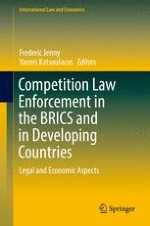
2016 | OriginalPaper | Buchkapitel
The Institutional Design of Competition Authorities: Debates and Trends
verfasst von : Frederic Jenny
Erschienen in: Competition Law Enforcement in the BRICS and in Developing Countries
Aktivieren Sie unsere intelligente Suche, um passende Fachinhalte oder Patente zu finden.
Wählen Sie Textabschnitte aus um mit Künstlicher Intelligenz passenden Patente zu finden. powered by
Markieren Sie Textabschnitte, um KI-gestützt weitere passende Inhalte zu finden. powered by